#tuatara anatomy
Note
hi, im a vet student and we just learnt about the parietal eye or "third eye" that some reptiles especies have and, well, im curious. do snakes have them? if not, do you know any reptiles that do? what do they use it for?
Hello hello - parietal eyes are really cool, huh? Snakes don't have them, but most lizards do.
In reptiles, the parietal eye is mostly a tool for regulating their circadian rhythm. It's covered by a thin layer of skin, but it can still pick up on light changes to help the reptile figure out what time of day it is. Light changes detected by the parietal eye actually trigger the production of hormones to encourag the reptile to thermoregulate! It's honestly used less as an eye and more as a tool for thermoregulation, which explains why mammals lost them - they're not needed for endothermic animals!
Like I said, the parietal eye is covered by a thin layer of skin, but you can see it really well on adult green anoles:

If you have a pet bearded dragon, you can see their parietal eye, too! Look for a little circle-shaped patch in the middle of their head behind their eyes.

Of all reptiles, the ones with the most well-developed parietal eyes are the tuatara. Tuatara look like lizards, but they're not - they're the sole living members of the sister order to Squamata (scaled reptiles, lizards and snakes): the Rhynchocephalia. The fact that tuatara have such well-developed parietal eyes tells us that most other rhynchocephalians probably did, too.

672 notes
·
View notes
Text
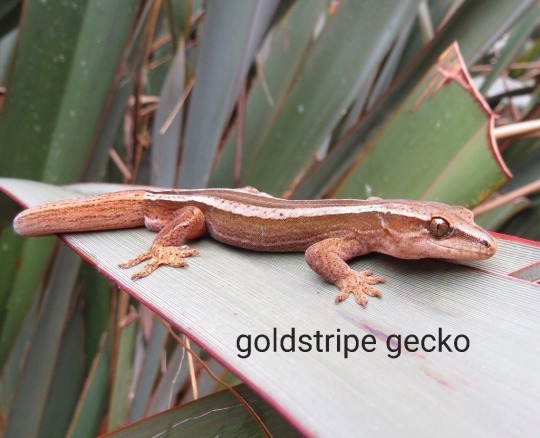

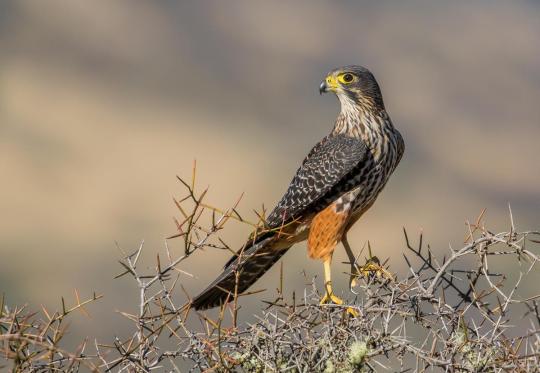


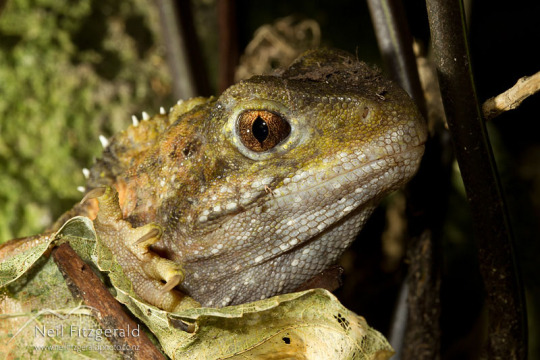
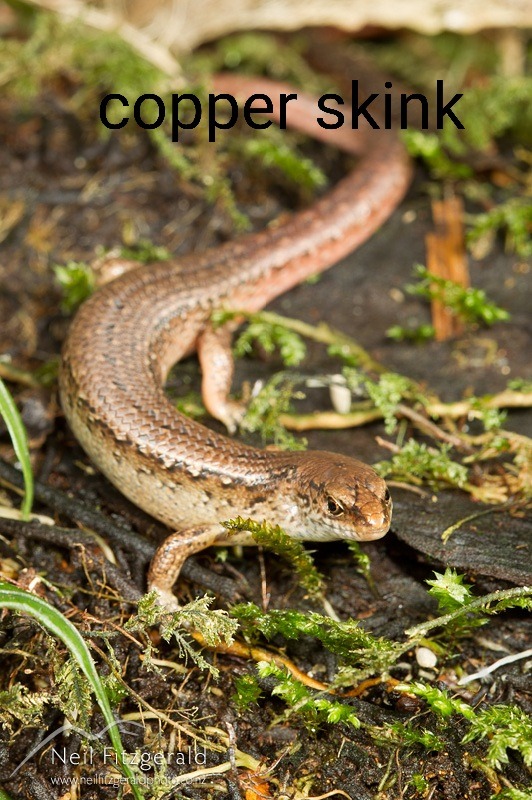
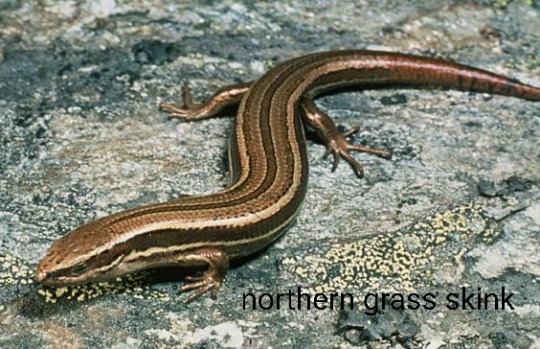
im doing some research on some native birds and other reptiles. i find that drawing is helpful for learning how their anatomy works
0 notes
Text
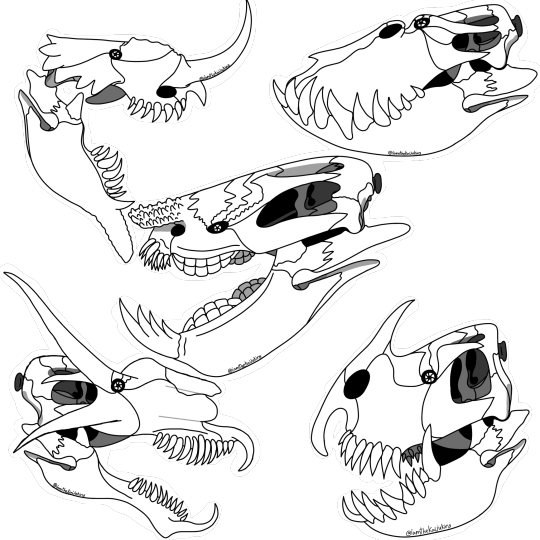


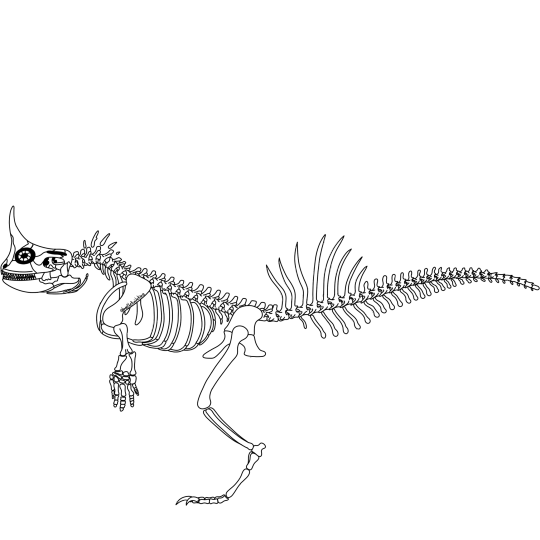
After completing the god children I took a short break before making the poster to have some bone fun.
Sawyer Lee made some skulls and turns out a lot of advanced dragons have open mandible fenestra, and I originally drew some skulls last year using tuatara anatomy but it turns out his dragons are equally related to squamates and Rhynchocephalia. So they all needed a touch up. I also did some arm bone anatomy, as his dragons also have 7 fingers, which I interpreted as a pinky that was duplicated twice. I also learned that most tetrapod hands don’t have the same amount of phalanges in their fingers as we do. While we have 2 phalanges for our thumbs and three in every other finger, amniotes started with a 2-3-4-4-5 arrangement.
Going from top left to right bottom in the top left picture: A Kinsbane, Mireworm, Clatterjaw, Scarlet Lasher, and Thundermaw
Second picture: Holdtaker, Shearwinter, Vilebrew, Kelpmonger, and Wroughtbelch
From top to bottom for the wings: Scarlet Lasher, Holdtaker, Kinsbane, and Spectacled dreadeye
The skeleton is of the most primitive dragon we’ve seen, the little guy sitting at the bottom of the cladograms we’ve been shown.
#speculative evolution#speculative anatomy#speculative biology#speculative zoology#skulls#skeletons#skeleton#anatomy#dragonslayer codex#bad fanart incoming#bones#art
20 notes
·
View notes
Text

Anatomy idea for mandrakes since I wanted to make them weirder. They are smallish (~3ft/ 1m tall) hind wing flyers from a large island chain that was magically separated from the main earth-like biotope, with many niches occupied by rhynchocephalians like themselves. They decended from a sharovipteryx-like rhynchocephalian ancestor that eventually achieved powered flight.
They have a very developed parietal (third) eye which aids them in navigation, circadian rhythm, and coordination when flocking. Their main eyes are very acute, with good color and motion vision. They have good night vision as well, with multiple rod types giving them nighttime color vision like the modern tuatara.
Unlike their vision, mandrake hearing is very poor. They can only reliably hear a small range of low frequency sounds. While they will sometimes make rumbling and croaking vocalizations, most mandrake language consists of body language and sign.
21 notes
·
View notes
Photo
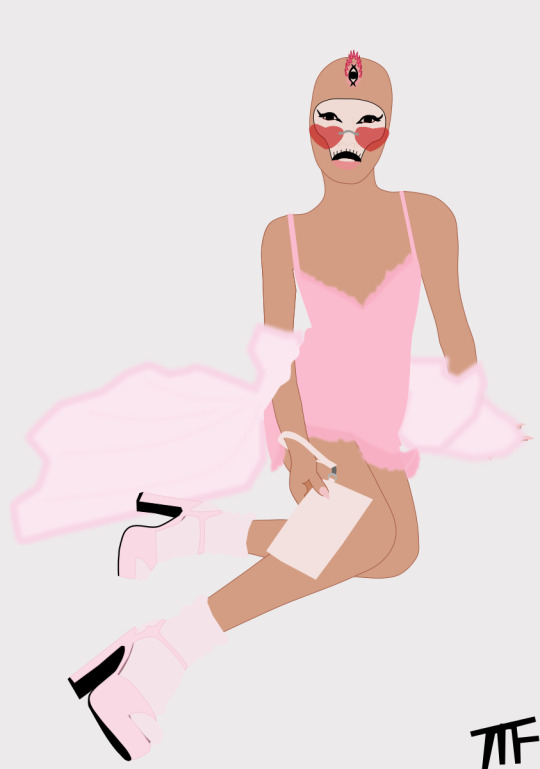
@niuniente
Here’s what my dumb questions were leading up to. I present: bubblegum Death-Head with extra eye and makeup. She’s a half-face tuatara, which have an extra eye on the top of their heads, though I took some liberties with the placement. She can’t see details with it but she can sense light and dark, like a real tuatara. She doesn’t have human ears, just little earholes like a lizard, so her glasses are actually magnetically attached to piercings she has right there. Her spikes go down her head and they’re naturally green, but she paints the ones on her head with nail polish. She used to always wear pink eyeshadow on all three eyes, but with her mask and all, now she only does the middle eye. She’s also got a tail that’s hidden in the shawl, because I cannot draw a lizard tail that doesn’t look terrible. And while I didn’t draw any teeth details, they’re very sharp, and she will not hesitate to bite.
I think I’m gonna call her Anahera, which is Maori for ���angel“ (since tuatara are from New Zealand)
Made in Inkscape, and I did it pretty fast, at least for me, so the anatomy isn’t exactly amazing lol.
(also the model I found to reference was already wearing the glasses, so I figured it was fate since it matches Alrick’s)
29 notes
·
View notes
Text
About the Blog
Hi! My name is Sam (they/them), and I’m a herpetologist who has had several years of reptile owning and handling experience.
There were no blogs for reptiles in general, so I decided to make one. Inspired by @is-the-snake-video-cute, as well as all the other animal video rating blogs.
I can generally answer any questions about reptiles, including husbandry, anatomy, handling, and identification. However, I am not professionally trained in reptile identification, but have learned from years in the hobby, so take my words with a grain of salt.
Reptile husbandry is complicated, and there are usually many right ways to care for a pet. Always consult multiple sources while researching for a new pet, and never impulse-purchase a living creature. If you have a husbandry question, I will answer with the general consensus of the reptile keeping community, and my personal opinion, but do not use this blog as your only resource.
Ratings
Red: The reptile or person(s) interacting with it are in active danger. This may be someone free-handling a venomous snake, a reptile being injured by a person or animal, or a seriously ill reptile.
Yellow: The reptile is not in active danger, but it is not being treated well. This may be bad husbandry such as small enclosures or incorrect temperatures.
Green: The reptile is happy and healthy. No one is in danger.
Blue: The reptile is unhealthy or in danger, but it is not the fault of a person mistreating it. This may be a reptile born with kinks in its spine, or a reptile killed by its natural predator. These are sad, but not a result of improper care or handling, just nature.
Purple: Uncertain. The video/picture doesn’t provide enough context for me to determine what the rating is.
Disclaimer
I consider myself pretty knowledgeable when it comes to animals, but at the end of the day, I’m just someone on the Internet who loves reptiles. I will make mistakes, and feel free to correct me if I get my facts wrong. There are also some types of reptiles that I don’t know much about, so I would recommend being cautious when asking me about them.
Reptiles I’m not very familiar with:
—Rhynchocephalia. I know almost nothing about tuataras, so I won’t really be able to answer questions about them.
—Amphisbaenidae. No one really knows much about them, but I’ve only barely researched them. I would recommend asking @is-the-snake-video-cute about them instead.
Do not ask urgent medical questions. I know what typical reptile illnesses look like, but I am not a professional and I can’t diagnose your reptile. If you ask about your reptile being sick, I will almost always recommend to go to a vet and not elaborate further.
Otherwise, ask away! I’ll accept pretty much anything as long as it has to do with reptiles. If you want, you can also just submit a video or photo of your pet being cute, or a cool reptile you found in the wild. There are no stupid questions, and I won’t judge you. If your video/photo isn’t rated well, please be kind and take it as constructive criticism. I am not making an attack on you personally, just spreading information so others don’t make the same mistakes. The ratings are meant for you to learn from them and change your behavior, too.
Have a great day! :D
#reptiblr#reptile#is the reptile video cute#rating#reptile videos#herpetology#snake#lizard#reptile blog#reptile husbandry#geckos#snake handling#lizard handling#reptile handling#venomous snakes#pet reptile#pets#pet snake#welcome post
0 notes
Note
I love your Glaurung design! Did you base it off any real types of lizards
-@outofangband
This is such a late response and I’m so sorry, but yes! I did base it on real lizards! For anatomy, I used Iguanas and Tuataras, but for the face I used a kind of Bearded Dragon/Dragon Lizard kind of combination. Not even gonna lie, Glaurung was actually the art work I put most research in, purely because he is one of those creatures that is only written, and there is not actual accurate way to show it. The same struggle happened with Ancalagon, though he was easier, as I went for the “typical dragon” look.
1 note
·
View note
Text
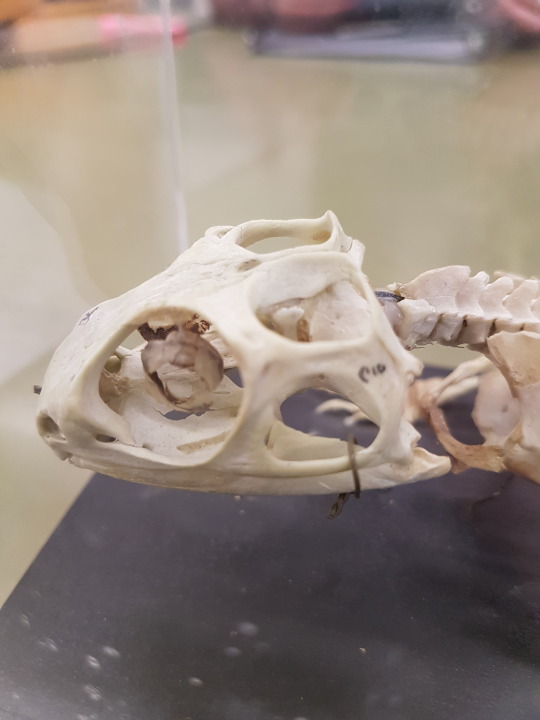
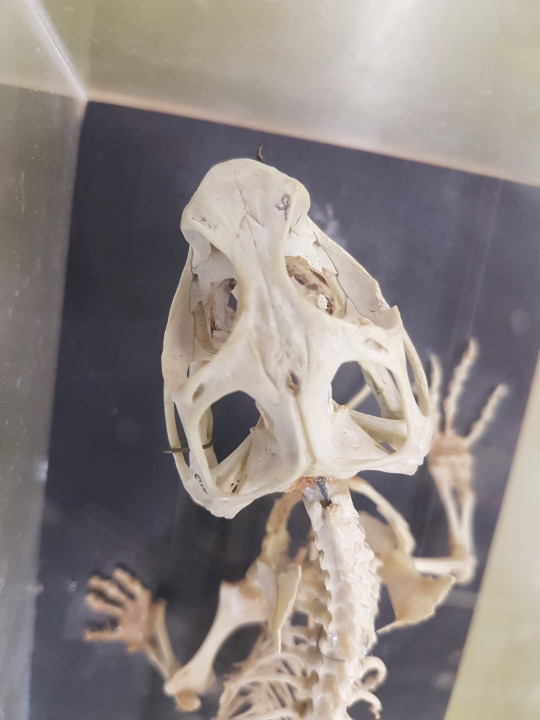
Tuatara skulls are truly beautiful.
Dead thing fact: Tuataras are unique in having a true diaspsid condition. They have two clear skull fenestras.
Juveniles also have a third eye on the top of their heads that remains somewhat functional in adults.
#deadthings#tuatara#skull#bones#skeleton#science#third eye#diapsid#biology#lab work#anatomy#halloween#spooky#vc#vulture culturw
336 notes
·
View notes
Text
Diphydontosaurus avonis
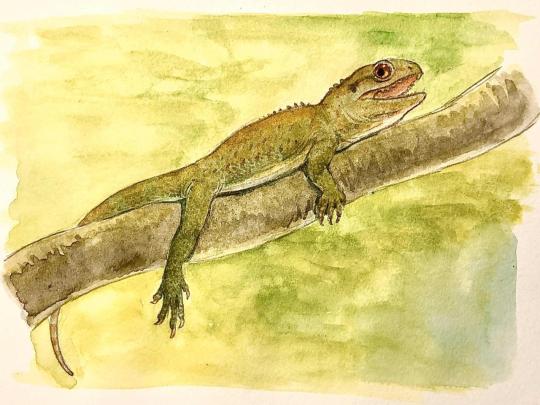
By Ripley Cook
Etymology: Reptile with two types of teeth
First Described By: Whiteside, 1986
Classification: Biota, Archaea, Proteoarchaeota, Asgardarchaeota, Eukaryota, Neokaryota, Scotokaryota Opimoda, Podiata, Amorphea, Obazoa, Opisthokonta, Holozoa, Filozoa, Choanozoa, Animalia, Eumetazoa, Parahoxozoa, Bilateria, Nephrozoa, Deuterostomia, Chordata, Olfactores, Vertebrata, Craniata, Gnathostomata, Eugnathostomata, Osteichthyes, Sarcopterygii, Rhipidistia, Tetrapodomorpha, Eotetrapodiformes, Elpistostegalia, Stegocephalia, Tetrapoda, Reptiliomorpha, Amniota, Sauropsida, Eureptilia, Romeriida, Diapsida, Neodiapsida, Sauria, Lepidosauromorpha, Lepidosauria, Rhynchocephalia, Sphenodontia
Referred Species: D. avonis
Status: Extinct
Time and Place: 227 to 200 million years ago, from the Norian to Rhaetian of the Late Triassic

Diphydontosaurus is known from Southern England and Wales, and possibly also from Northern Italy.

Physical Description: Diphydontosaurus is an early-derived relative of the tuatara, one of the oldest in fact. Like the tuatara, it resembles a lizard in appearance, probably even more so than living tuataras. It was also very small too. Like, really small. 10 centimetres long from head-to-tail with a skull less than 15 millimetres long, small. The skull itself has massive eyes and a pretty short snout, so it was probably a rather cute looking little reptile. The most distinctive features of Diphydontosaurus are its jaws and teeth. Living tuataras have their teeth fused to the jaw bones (acrodont), which wear down and can’t be replaced. Diphyodontosaurus has these teeth at the back of its jaws, but the teeth in front were attached in sockets (pleurodont), like some lizards. These teeth were sharp and peg-like, perfect for puncturing the carapaces of insects, while the teeth at the back formed a shear for slicing through them. Diphydontosaurus also lacked the characteristic “beak” at the tip of the jaws found in later sphenodonts, and probably didn’t chew its food the way modern tuataras can (yes, tuataras can chew). Diphydontosaurus would also have had a typmanum, a.k.a. an eardrum, visible at the back of its head, again like most lizards but unlike the living tuatara.
Diet: Diphydontosaurus was insectivorous, as evidenced by its small size and teeth, although like some living insular lizards it may have eaten plants to supplement its diet.
Behavior: Diphydontosaurus was likely an active predator or insects and other small arthropods. Its large eyes and well developed ear openings indicate that it likely relied heavily on these senses for hunting and catching prey. They may have especially congregated around the abundant fissures and sinkholes in their habitat, where moist soils and plants would have attracted plenty of insects and other arthropods, and so too the Diphydontosaurus. Being small would have been handy for clambering over steep rock faces after prey, out of reach of other, larger reptiles.
Ecosystem: Diphydontosaurus was part of a diverse collection of island ecosystem in the latest Triassic of Europe, populating low-lying islands of limestone pockmarked with deep fissures and caves eroded into the karst. The species found on each island differed, but there was some broad similarities. The largest land animals on these islands were the possibly dwarfed prosauropod dinosaurs Thecodontosaurus and Pantydraco, as well as small theropods. Pseudosuchian archosaurs were here too, including the small predator Terrestrisuchus and the enigmatic Aenigmaspina, both extremely long-legged, agile animals well suited for navigating the karst-riddled landscape. There was also a drepanosaur around, as well as the gliding reptiles Kuehneosaurus and Kuehneosuchus whose affinities remain mysterious. They could be lepidosaurs like sphenodonts, or, they may belong to the strange allokotosaurs on the archosaur side of the tree! The jury is still out on them. Some of the islands also hosted small mammaliaforms, including Morganucodon and Eozostrodon.
Stem-tuataras like Diphydontosaurus were remarkably diverse, and it coexisted with numerous other genera such as Gephyrosaurus, Clevosaurus, and Planocephalosaurus, each with multiple species, and there are still more new types of sphenodont to be described! Such a high density of different sphenodonts on these islands implies they were all specialised for different ways of life. Diphydontosaurus was one of the most abundant of all sphenodonts on the islands of Late Triassic Europe, no doubt thanks to its small size and insectivorous diet. However, this small size left it vulnerable, and it may have been preyed upon by its larger, more predatory cousins like Clevosaurus.
Other: Diphydontosaurus is one of the oldest known, and is the earliest diverging, sphenodont, the group of animals that includes living tuataras but excludes the even earlier-diverging rhyncocephalians, the gephyrosaurids (the distinction isn’t huge, mostly that gephyrosaurids have completely pleurodont teeth). The anatomy of Diphydontosaurus was unexpected compared to modern tuataras, which are so often described as ‘living fossils’ unchanged since the Mesozoic. In fact, certain features of Diphydontosaurus and other early sphenodonts reveal that the modern tuatara is actually pretty derived compared to its ancestors, especially so in the skull, including the loss of its external ears, its shearing teeth and the ability to chew food. Diphydontosaurus really just goes to show you can’t judge a 200 million year old clade by its sole extant member, eh?
~ By Scott Reid
Sources under the Cut
Whiteside D.I. (1986). "The head skeleton of the Rhaetian sphenodontid Diphydontosaurus avonis gen. et sp. nov., and the modernising of a living fossil". Philosophical Transactions of the Royal Society B. 312 (1156): 379–430.
Whiteside, D.I., Duffin, C.J., Gill, P.G., Marshall, J.E.A., Benton, M.J. (2016). “The Late Triassic and Early Jurassic fissure faunas from Bristol and South Wales: stratigraphy and setting”. Palaeontologia Polonica 67, 257–287.
David I. Whiteside, Christopher J. Duffin, (2017). "Late Triassic terrestrial microvertebrates from Charles Moore's "Microlestes" quarry, Holwell, Somerset, UK". Zoological Journal of the Linnean Society. 179 (3): 677–705.
Whiteside, D.I., Marshall, J.E.A. (2008). "The age, fauna and palaeoenvironment of the Late Triassic fissure deposits of Tytherington, South Gloucestershire, UK". Geological Magazine. 145 (1): 105–147.
#Diphydontosaurus#Diphydontosaurus avonis#Sphenodont#Tuatara#Reptile#Prehistoric Life#Palaeoblr#Paleontology#Prehistory#Triassic#Triassic Madness#Triass March Madness
217 notes
·
View notes
Text
Buitreraptor gonzalezorum
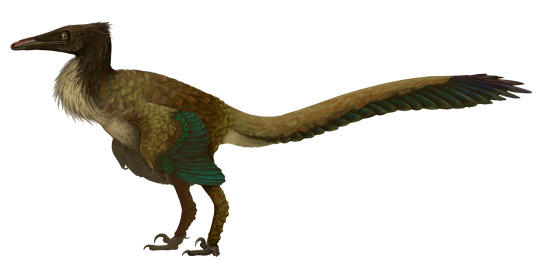
By Scott Reid
Etymology: Vulture Thief
First Described By: Makovicky et al., 2005
Classification: Dinosauromorpha, Dinosauriformes, Dracohors, Dinosauria, Saurischia, Eusaurischia, Theropoda, Neotheropoda, Averostra, Tetanurae, Orionides, Avetheropoda, Coelurosauria, Tyrannoraptora, Maniraptoromorpha, Maniraptoriformes, Maniraptora, Pennaraptora, Paraves, Eumaniraptora, Dromaeosauridae
Status: Extinct
Time and Place: Between 100 and 97 million years ago, in the Cenomanian of the Late Cretaceous


Buitreraptor is known from the Candeleros Formation of Neuquén, Argentina

Physical Description: Buitreraptor was a small dromaeosaur, and of the kinds adapted extensively for aquatic life. It had a very long, flat snout, with numerous small curved teeth. It had long, thin forearms, and similar legs. It was extremely long in general, except for the fact that it had small fingers and toes. It had a thin ribcage and a long, skinny tail that was stiffened into a straight shape, and it wouldn’t have been very flexible. As a Dromaeosaur, Buitreraptor would have been covered in feathers, which would have been fluffy all over its body. It probably would have had a long tail fan, and it definitely had wings - which most likely fully feathered and with long, bird-like feathers, though that’s up to some debate due to Buitreraptor’s different arm structure.
Buitreraptor is extremely unique in general, with its long thin snout being distinctive amongst other raptors. Its small claws on its wings and feet contrast greatly with the general elongate nature of its head, body, limbs, and tail. In other ways, it is an intermediate between the earliest Paravians - birds and their closest “classical dinosaur” relatives - and more derived dromaeosaurs like Velociraptor. It was about 1.5 meters long.

By Conty, CC BY 3.0
Diet: The diet of Buitreraptor is under some debate, but it seems likely that it was at least partially piscivorous.
Behavior: Buitreraptor would have probably spent much of its days around sources of water, reaching in with its long jaws to catch fish in the water. When fish wasn’t an option, it would have opted for other small animals, such as tiny lizards and mammals. It probably wouldn’t have engaged largely in the hunting of large prey, given the lack of serrations on its teeth; instead, Buitreraptor would have just jutted forward, striking quickly to avoid utilizing its claws in the hunt. It probably wouldn’t have engaged in raptor-prey-restraint or wing-assisted-incline-running, since its arms were differently structured than living birds and other Dromaeosaurs, and it’s unlikely that it would have had as extensive of a wing surface.
Buitreraptor is known from multiple skeletons found together, indicating that it probably would have lived in family groups if nothing else, though they didn’t need to pack hunt since they mainly ate small animals and fish. These family groups would probably have communicated largely through display, with the wings and tail fan of Buitreraptor used to express interest in mating, discovery of food, and aggression. As in other dinosaurs, Buitreraptor most likely took care of its young, though fossil evidence for that is not known at this time. More individuals have been found of Buitreraptor over the years, indicating it was quite a common fixture in its environment.

By José Carlos Cortés
Ecosystem: Buitreraptor lived in the Cretaceous of South America, a time of many environments transitioning from one to another in a beautiful succession of a specific type of environment compared to the surrounding areas. Whereas North America had Dromeaosaurs fulfilling the mid-sized predator role, South America had Megaraptors instead, whereas the Dromaeosaurs of South America were fishermen! Here there were many types of Titanosaurs, sometimes living together in the same environment; and large Carnosaurs and Abelisaurids present to hunt them. Instead of Hadrosaurs, there were the weird Elasmarians; and Ceratopsians were nowhere to be seen. The Candeleros Formation in particular occurred in the middle of the Cretaceous, and it is the earliest of the very well known of these environments (the one just underneath it shows a transition from the time of the last Diplodocoids (whip-tailed) sauropods to the time of the Titanosaur Uprising). Here, there was the titanosaur Andesaurus and some of the last Diplodocoids Limaysaurus, Nopcsaspondylus, and Rayososaurus; an Alvarezsaurid Alnashetri, a mysterious Coelurosaur Bicentenaria, an abelisaurid Ekrixinatosaurus, and unnamed probable Elasmarian, and one of the largest carnivorous dinosaurs, Giganotosaurus, which would have been a real and present danger for Buitreraptor. Interestingly enough, the next formation in the series doesn’t have this behemoth, but it does have the impossibly large Argentinosaurus.

By Ripley Cook
This formation was a braided river system, with a variety of swamps and rich soil, and extensive sand deposits surrounding the swamps. Buitreraptor especially would have taken extensive advantage of the swamps, fishing in this wet habitat rather in the more semi-arid land around it. There were plenty of fish, frogs, tuatara relatives, turtles, and even a primitive snake for Buitreraptor to eat; in addition to some early mammals.
Other: Buitreraptor is a member of the Unenalgiines, which are a unique group of raptors in a variety of ways: they are some of the earliest to branch off from the rest; they are the only ones known from South America; and they are probably at least partially adapted for a water-based lifestyle rather than the hypercarnivorous lifestyle of their northern relatives. This makes Buitreraptor and its relatives of vital importance for understanding the evolution of raptors; it seems that these dinosaurs migrated down to the southern continent early in the Cretaceous period, and given one of the most basal raptors is known to be aquatic, simply adapted even more thoroughly for a water-based lifestyle.
~ By Meig Dickson
Sources under the Cut
Gianechini, F.A.; Apesteguía, S.; Makovicky, P.J (2009). "The unusual dentiton of Buitreraptor gonzalezorum (Theropoda: Dromaeosauridae), from Patagonia, Argentina: new insights on the unenlagine teeth". Ameghiniana. 46 (4): 29R.
Gianechini, F. A., P. J. Makovicky, and S. Apesteguía. 2011. The teeth of the unenlagiine theropod Buitreraptor from the Cretaceous of Patagonia, Argentina, and the unusual dentition of the Gondwanan dromaeosaurids. Acta Palaeontologica Polonica 56(2):279-290
Gianechini, F. A., P. J. Makovicky, and S. Apesteguía. 2017. The cranial osteology of Buitreraptor gonzalezorum Makovicky, ApesteguÍa, and AgnolÍn, 2005 (Theropoda, Dromaeosauridae), from the Late Cretaceous of Patagonia, Argentina. Journal of Vertebrate Paleontology 27(1):e1255639:1-19
Gianechini, F. A., P. J. Makovicky, S. Apesteguía. 2018. Postcranial skeletal anatomy of the holotype and referred specimens of Buitreraptor gonzalezorum Makovicky, Apesteguía, and Angolín 2005 (Theropoda, Dromaeosauridae), from the Late Cretaceous of Patagonia. PeerJ 6: e4558.
Leanza, H.A.; S. Apesteguia; F.E. Novas, and M.S. De la Fuente. 2004. Cretaceous terrestrial beds from the Neuquén Basin (Argentina) and their tetrapod assemblages. Cretaceous Research 25. 61–87.
Makovicky, P. J., S. Apesteguía, and F. L. Agnolín. 2005. The earliest dromaeosaurid theropod from South America. Nature 437:1007-1011
Motta, M. J., F. Brissón Egli, F. E. Novas. 2018. Tail anatomy of Buitreraptor gonzalezorum (Theropoda, Unenlagiidae) and comparisons with other basal paravians. Cretaceous Research 83: 168 - 181.
Novas, F. E., F. Brissón Egli, F. L. Angolín, I. Cerda. 2018. Postcranial osteology of a new specimen of Buitreraptor gonzalezorum (theropoda, Unenlagiidae). Cretaceous Research 83: 127 - 167.
Sánchez, María Lidia; Susana Heredia, and Jorge O. Calvo. 2006. Paleoambientes sedimentarios del Cretácico Superior de la Formación Plottier (Grupo Neuquén), Departamento Confluencia, Neuquén (Sedimentary paleoenvironments in the Upper Cretaceous Plottier Formation (Neuquen Group), Confluencia, Neuquén). Revista de la Asociación Geológica Argentina 61. 3–18.
Wichmann, R. 1929. Los Estratos con Dinosaurios y su techo en el este del Territorio del Neuquén ("The dinosaur-bearing strata and their upper limit in eastern Neuquén Territory"). Dirección General de Geología, Minería e Hidrogeología Publicación 32. 1–9.
#Buitreraptor#Buitreraptor gonzalezorum#Dinosaur#Raptor#Bird#Birds#Feathered Dinosaurs#Dinosaurs#Dromaeosaur#Water Wednesday#Piscivore#South America#Cretaceous#palaeoblr#paleontology#prehistory#prehistoric life#biology#a dinosaur a day#a-dinosaur-a-day#dinosaur of the day#dinosaur-of-the-day#science#nature#factfile#Birblr
246 notes
·
View notes
Photo

(Photo credit: AP Photo/NZPA, Dianne Manson)
Say hello to Henry: he's a tuatara (Sphenodon Punctatus), the last species remaining from the order Rhynchocephalia.
This is a species that I completely adore, and one day I'd love to at least see one if person. If I can ever hold one of these big wrinkly squish boys in my own two hands, I will be able to die happy. Here's some of the interesting stuff I've learned about them!
Tuataras are incredibly special (and I'm not just saying that because I love their plump bodies). They are not actually lizards; lizards and snakes belong to a different order (Squamata), but they are still reptiles. Tuataras are native to New Zealand, though they have been greatly threatened by habitat desctruction and invasive species, and they now mostly inhabit surrounding islands.
These guys can live to be whopping 100 years old! Henry here even reproduced at the age of 111. It's possibly tuataras could live to be close to 200 years old in captivity. They are considered to be a more primitive reptile in terms of anatomy, similar to turtles, but they have beak-like skulls similar to birds. Unlike most reptiles, tuataras can also tolerate some pretty low temperatures! In fact, higher temperatures that most reptiles can't even bask in would cause a tuatara to overheat.
Due to their threatened species status, only a few zoos in the US have tuataras in their possession. In New Zealand, many zoos have worked together to help conserve this "living fossil", and there has been some positive progress made. There's hope for the tuatara yet!
This is a fascinating species to research for anyone who is interested in herpetology, biology, or other natural sciences. Let's hope that our little guys have a bright future ahead!
If I got any of my information wrong just let me know, or if anyone has anything to add, please feel free! I love to learn.
328 notes
·
View notes
Note
Thank you for you blog! I love it so much - I come here daily to read your latest posts.
I'd love to own a snake but alas, I currently live in New Zealand so no snakes for me.
Do you have cool facts about tuatara? I do but I'd love readers of your blog to learn about these cool little reptiles!
It's a huge dream of mine to work with tuatara one day! I've always loved the reptile life of Oceania and literally the only reason I haven't already moved to Australia or even Aotearoa/NZ is because of the limitations on keeping non-native species.
Anyway, aren't tuatara just the coolest? For those unfamiliar, tuatara (Sphenodon punctatus) might look like lizards, but they're not! Tuatara are the only surviving members of Rhynchocephalia, the sister order to Squamata, the scaled reptiles (lizards, snakes, and amphisbaenians).

Rhynchocephalians used to be very widespread, but today they exist only in limited populations in Aotearoa. They were almost driven to extinction by habitat loss and pressure from invasive species, and for a long time the only wild populations were on offshore islands. In a huge success for tuatara conservation, though, populations were reintroduced onto the North Island and there are now hatchlings being born on the North Island for the first time in centuries. There's still so much work to be done to help these amazing reptiles, but it's worth celebrating! The Chester Zoo in England has also welcomed tuatara hatchlings, meaning tuatara have been successfully bred outside of Aotearoa for the first time and indicating possible future success for wider zoo breeding programs across the world!
Tuatara have many anatomical features that are unique among reptiles, and they tell us a lot about the extinct rhynchocephalians. Their teeth arrangement is unique among reptiles, and their lower jaws can slide to cut through bone. They're the only known amniotes who have hourglass-shaped vertebrae, and they have gastralia (belly ribs). Even if they might look kinda like lizards on the outside, their skeleton is wildly different!

Tuatara have the most well-developed parietal eyes of any vertebrates. These are "third eyes" that sit on top of the head, and in most reptiles who have them they're extremely primitive, but in tuatara they have well-developed retinas and a cornea-like structure! Parietal eyes are covered by a thin layer of skin and probably help with thermoregulation and day/night cycle regulation.

They are carnivores and eat a wide diet of insects, lizards, and birds. Juvenile tuatara will hunt during the day so they can avoid being eaten themselves by adult tuatara, who hunt at night.
The name "tuatara" comes from te reo Māori, and means "peaks on the back," a reference to the spines along a tuatara's back. Tuatara are sexually dimorphic, and the spines are larger and more rigid in males. They're used in breeding and defensive displays!
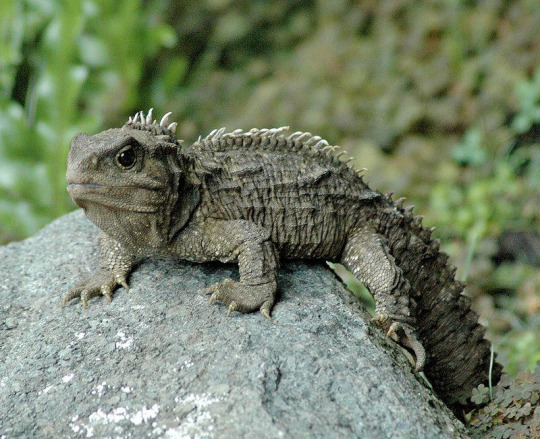
One of the challenges for tuatara conservation is how long it takes them to reach sexual maturity - about 10-20 years, and they tend to have very small egg clutches. They've been recorded to lay up to 19 eggs, but a more typical clutch is as small as 3-6 eggs or even a single egg. These eggs also take over a year to be laid and hatch. They have the slowest growth rates of any reptile, reaching full size at around 30 years and having an average lifespan of around 60 but lifespans closer to 100 not being uncommon.
The oldest known tuatara is named Henry, and he lives at the Invercargill museum on the South Island. He's at least 120 but may be as old as 150, and is still fathering healthy clutches!

Tuatara are simply incredible. They're so unique among living reptiles, and they have so much to tell us about a mostly-extinct order of reptiles. Plus, like, you can't deny they're so cool and adorable!
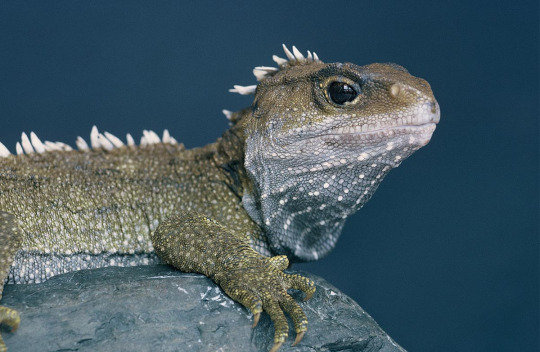
#not a rating#tuatara#tuatara anatomy#sorry for the long post. being asked to talk about tuatara awakens something within me#long post
363 notes
·
View notes
Text
CHIMERA PROJECT; SUBJECT FILE: 251-B “BOON”
Status of Subject: Living
Location of Subject: Confinement Room B
Gender: N/A
Age: N/A
Height: 5′ 0″
Weight: 120 lbs
Race: Faunus
Included Genetics:
- Coronella Austriaca (Smooth Snake)
- Takydromus Sexlineatus (Long-Tailed Lizard)
- Monitor Lizard
- Furcifer Pardalis (Panther Chameleon)
- Sphenodon Punctatus (Tuatara)
Subject Description:
Subject 251-B, or “Boon” as it’s keeper has nicknamed it, is the first success in the Chimera Project. Furthermore, 251-B is the only living subject of test #251 which was carried out on twins. 251-A did not survive the first round of modifications.
251-B measures five feet tall when standing upright. Their skin scaled, silver grey in color, and smooth to the touch. Their body is rather small despite original expectations, but possesses enough muscle mass and fat that there is no worry about the subject’s physical health.
The subject’s body was originally that of a female, but due to some of the treatments they received, it has become difficult to tell whether the subject is male or female from first glance. Though while they still possess their original anatomy, they have become infertile. The specifics on how and why will not be discussed in his file.
Low on their back, an inch above their buttock, a thin, five-foot long tail extends out and down from the body to a tapered point. The result of the Takydromus Sexlineatus Faunus DNA. Subject 251-B’s tail is fully prehensile, as we hoped with the addition of the Furcifer Pardalis Faunus DNA. The tail is also covered entirely with the same scales as the rest of their body.
Subject’s eyes are bright blue with vertical slit pupils. This allows 251-B to be able to see a wider range of colors. They also seem to be able to track movement of others quite well. On top of this, while no-one has seen it in person, security camera footage has shown that their pupils can dilate. This likely allows for the subject to be able to see better in lower light.
It is also theorized by their keeper that such change in the pupil also occurs whenever the subject is looking at something they like. This can be backed by the fact that 251-B’s pupils tend to be dilated when they are given their meals and while they are eating. Though there has yet to be any other scenario where the subject’s pupils have been dilated.
Subject 251-B’s mouth is similar to that of any other Human or Faunus, and contains the same teeth, however there are four extra rows of teeth. These extra rows are only slightly longer than the normal ones, about a quarter of an inch, and are curved to a sharp, pointed end. However, upon further study, it turns out these aren’t like normal teeth, as they are part of the subject’s jaws. Likely the result of the Sphenodon Punctatus Faunus DNA.
251-B’s Tongue is also different from that of a Human’s or any non-reptilian Faunus, being thin and forked instead. Measurements have shown that it is able to extend six inches out of their mouth. They tend to extend the tongue, flicking it through the air rapidly for less than a second before retracting it whenever anyone is near them, or they are in a new, unfamiliar location.
Tests have revealed that this is done because, like their animal counterparts, they have sensory organs within the roof of their mouth. Though the subject’s sensory organ is smaller than it should be given their size in comparison, likely due to anatomical differences. Due to this, it is not as useful as that of their counterparts. Still, it allows for them to become more aware of their surroundings and of certain scents.
Down the center of the Subject’s chest is a long, somewhat deep scar. This is from experiments and testing that has been done, and the incision made healed perfectly. There is another, smaller scar similar to this on the back of their neck.
5 notes
·
View notes
Text
The mystery of bizarre holes in T. rex's head might finally be solved
https://sciencespies.com/nature/the-mystery-of-bizarre-holes-in-t-rexs-head-might-finally-be-solved/
The mystery of bizarre holes in T. rex's head might finally be solved
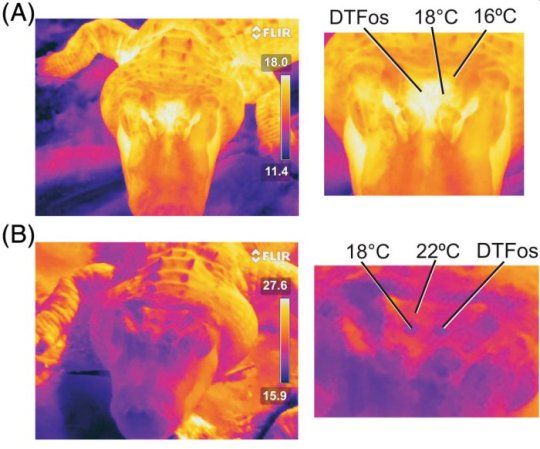
Despite its popular image of teeth and claws and thunder, Tyrannosaurus rex was no hot-head. New research indicates that the two mysterious holes in the top of the dinosaur’s skull likely helped regulate temperatures inside its head.
Previously, these holes – called the dorsotemporal fenestra – were thought to be filled with muscles that helped operate the powerful jaw. But, according to anatomist Casey Holliday of the University of Missouri, something didn’t quite add up.
“It’s really weird for a muscle to come up from the jaw, make a 90-degree turn, and go along the roof of the skull,” he said.
“Yet, we now have a lot of compelling evidence for blood vessels in this area, based on our work with alligators and other reptiles.”
Similar fenestra can be found in the skulls of a class of animals known as diapsids, grouped together because of this feature. This class includes not only crocodilians, but also birds, lizards, and tuatara; the holes are thought to have evolved about 300 million years ago.
Fenestra are not found in all dinosaur skulls, but those that do have them include tyrannosaurs and pterosaurs. To start figuring out what these holes were for, the team analysed different diapsid skulls to determine which ones had fenestra most similar to T. rex; the closest similarities turned out to be with crocodilians.
So, Holliday and his co-authors – William Porter and Lawrence Witmer from Ohio University, and Kent Vliet of the University of Florida – took thermal imaging cameras and went to study a bunch of alligators at the St Augustine Alligator Farm Zoological Park.
Because alligators are cold-blooded, or ectothermic, their body temperature is dependent on the temperature of their environment. This means that their thermoregulation processes are very different from warm-blooded, or endothermic, organisms.
vimeo
More
“We noticed when it was cooler and the alligators are trying to warm up, our thermal imaging showed big hot spots in these holes in the roof of their skull, indicating a rise in temperature,” Vliet said.
“Yet, later in the day when it’s warmer, the holes appear dark, like they were turned off to keep cool. This is consistent with prior evidence that alligators have a cross-current circulatory system – or an internal thermostat, so to speak.”

(Holliday et al., The Anatomical Record, 2019)
It’s not yet known whether dinosaurs in general, and T. rex in particular, were ectothermic or endothermic.
The topic is actually hotly debated, with some scientists thinking the former, some the latter, and some believing dinosaurs fell somewhere between the two – a feature called mesothermy. Previous research has suggested that the armoured ankylosaur had “crazy straw” tunnels in its skull to help keep its brain at optimum temperatures.
Now this research suggests that T. rex (and other dinosaurs) use some of the thermoregulation tactics of ectotherms, but what that actually means within the broader context of their metabolisms is yet to be explored.
What the scientists can tell, based on this research, is that there are no osteological features on the skull of the tyrannosaurus that indicate the fenestra were sites of muscle attachment. They can also infer, based on modern alligators, that the fenestra could have been used to regulate temperature in the T. rex‘s skull, by warming or cooling the blood that flows through blood vessels in the structures.
“We know that, similarly to the T. rex, alligators have holes on the roof of their skulls, and they are filled with blood vessels,” Witmer said.
“Yet, for over 100 years we’ve been putting muscles into a similar space with dinosaurs. By using some anatomy and physiology of current animals, we can show that we can overturn those early hypotheses about the anatomy of this part of the T. rex‘s skull.”
The team’s research has been published in The Anatomical Record.
#Nature
0 notes
Text

I posted 39,420 times in 2022
That's 9,773 more posts than 2021!
6 posts created (0%)
39,414 posts reblogged (100%)
Blogs I reblogged the most:
@flange5
@luidilovins
@spongebobssquarepants
@bloodfetcher
@renthony
I tagged 928 of my posts in 2022
#toh spoilers - 24 posts
#hot damn - 18 posts
#stained glass my beloved - 12 posts
#youtube - 11 posts
#i don't go here but - 11 posts
#flashing lights - 7 posts
#hell yeah - 7 posts
#mochi - 7 posts
#i love her - 6 posts
#owl house spoilers - 5 posts
Longest Tag: 139 characters
#i got distracted trying to decide if i'm too tired to make myself dinner or if i should just eat a snack and go to bed because it's 9pm lol
My Top Posts in 2022:
#5
My roommates are throwing a party and it's so fucking loud and I can't sleep and this is a fucking autistic/PTSD sensory hell
3 notes - Posted May 1, 2022
#4
Fun fact, blaze posts ignore tag filters. Also I'm not sure how well Tumblr screens blazes before they post.

@staff
[Brief image description: a tumblr blaze sponsered post to a fic that is tagged with both "dead dove: do not eat" and "incest"]
3 notes - Posted April 28, 2022
#3
It's my birthday today
4 notes - Posted June 19, 2022
#2

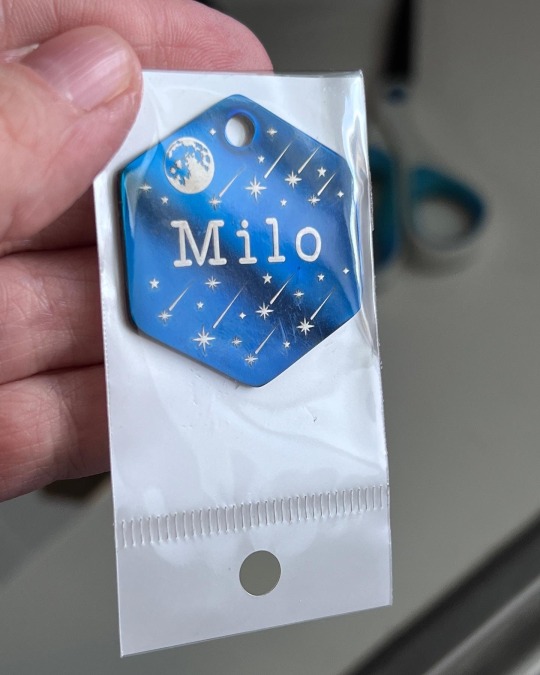
Mr. Man got his first-ever tag today and is very proud of it!! I’m so in love with the tags we got all 3 of my dogs (they’re the same but Milo’s is blue, Laika’s is gold, and Loki’s is black) that I’m gonna get 3 more with their names to use as keychains lol (I have no idea why I call him Mr. Man, it just came out one day and now I can’t stop lmao)
Those are amazing tags and now I want one for my dog lol. I want to get my dog a collar with a matching bracelet for me
Also I'm now going to accept that Man is his last name (or middle name if you consider your dogs to have your last name)
4 notes - Posted March 17, 2022
My #1 post of 2022
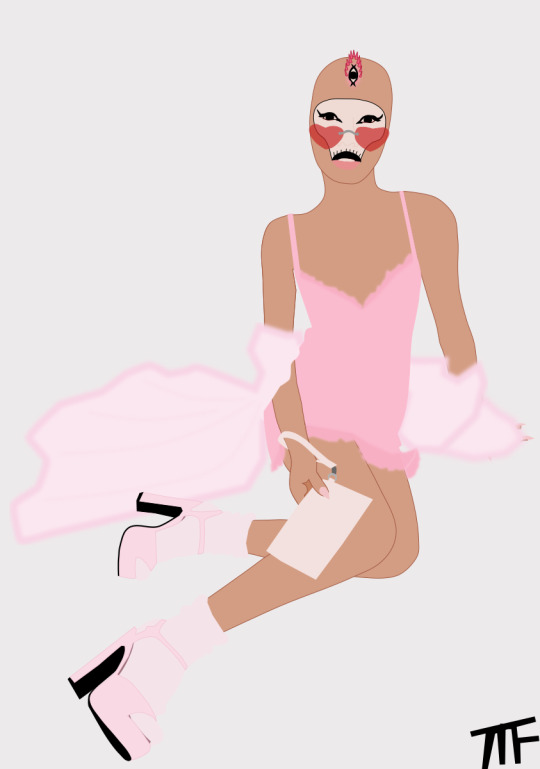
@niuniente
Here’s what my dumb questions were leading up to. I present: bubblegum Death-Head with extra eye and makeup. She’s a half-face tuatara, which have an extra eye on the top of their heads, though I took some liberties with the placement. She can’t see details with it but she can sense light and dark, like a real tuatara. She doesn’t have human ears, just little earholes like a lizard, so her glasses are actually magnetically attached to piercings she has right there. Her spikes go down her head and they’re naturally green, but she paints the ones on her head with nail polish. She used to always wear pink eyeshadow on all three eyes, but with her mask and all, now she only does the middle eye. She’s also got a tail that’s hidden in the shawl, because I cannot draw a lizard tail that doesn’t look terrible. And while I didn’t draw any teeth details, they’re very sharp, and she will not hesitate to bite.
I think I’m gonna call her Anahera, which is Maori for “angel“ (since tuatara are from New Zealand)
Made in Inkscape, and I did it pretty fast, at least for me, so the anatomy isn’t exactly amazing lol.
(also the model I found to reference was already wearing the glasses, so I figured it was fate since it matches Alrick’s)
30 notes - Posted September 27, 2022
Get your Tumblr 2022 Year in Review →
1 note
·
View note
Link
We generally perceive Tyrannosaurus rex as a ferocious animal always seething with rage. However, a new study has indicated that the presence of two mysterious holes on its skull might have helped in controlling the temperature inside its head. The work appears in The Anatomical Record.
Earlier these holes also termed as dorsotemporal fenestra were considered to be only occupied by muscles which helped in the operation of its jaw. Casey Holliday, an anatomist from the University of Missouri said that it was strange for a muscle to extend from the jaw till the top of the skull. But now enough evidence has been gathered from alligators and other reptiles which suggest the presence of blood vessels in this region. Similar fenestra has been observed in the skulls of animals collectively termed as diapsids. It includes crocodilians, birds, lizards, and tuatara. It is estimated that the holes evolved nearly 300 million years ago. Fenestra can be found in tyrannosaurs and pterosaurs. The team analyzed several diapsid skulls to find out which animals had fenestra resembling T.rex; the closest one was crocodilians.
Holliday and his team members, William Porter, Lawrence Witmer from Ohio University and Kent Vliet, University of Florida used thermal cameras for studying alligators at St Augustine Alligator Farm Zoological Park. The body temperature of alligators is dependent on the temperature of the surroundings since they are cold-blooded. As a result of which their thermoregulation processes are different from the warm-blooded or endothermic animals.
“We noticed when it was cooler and the alligators are trying to warm up, our thermal imaging showed big hot spots in these holes in the roof of their skull, indicating a rise in temperature,” Vliet said.
“Yet, later in the day when it’s warmer, the holes appear dark, like they were turned off to keep cool. This is consistent with prior evidence that alligators have a cross-current circulatory system – or an internal thermostat, so to speak.”
It is not sure if dinosaurs were endothermic or ectothermic and this is a topic of heavy debate. Some scientists think they were in between the two categories i.e a feature called mesothermy. Previous research suggested that armoured ankylosaur had tunnels in the skull for keeping the brain at optimum temperatures.
It is suggested that T.rex use few thermoregulation tactics of the ectotherms. It can, however, be confirmed that there are no osteological features on the skull of tyrannosaurus which shows that fenestra were extensions of muscle attachment. They can also infer, based on modern alligators that Fenestra could have been used for controlling the temperature in the skull of T.rex by warming or cooling the blood flowing through blood vessels.
Witmer said that similar to T.rex, alligators have holes on their skull-tops which are filled with blood vessels. But still, muscles have been grouped with dinosaurs. The anatomy and physiology of the present-day animals can be used to discard the early hypotheses.
Journal Reference: The Anatomical Record.
The post Researchers might have finally solved the mystery of holes in the head of tyrannosaurus rex appeared first on ScienceHook.
via Science Blogs
0 notes